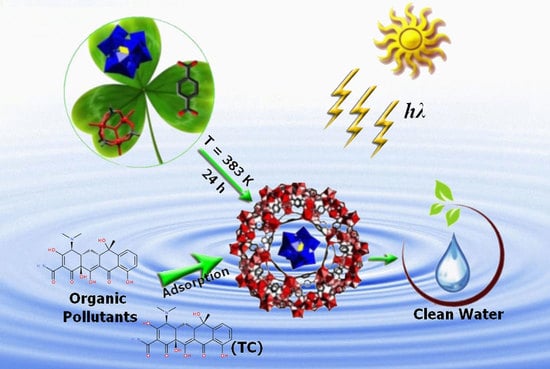Filling Polyoxoanions into MIL-101(Fe) for Adsorption of Organic Pollutants with Facile and Complete Visible Light Photocatalytic Decomposition
Abstract
:1. Introduction
2. Experimental Section
2.1. Synthesis of POM@MIL-101(Fe) Composites
2.2. Antibiotic Adsorption Examinations
2.3. Calculation of Adsorption Capacity and Adsorption Rate (Adsorption%)
2.4. Photoregeneration of PWV2
3. Results and Discussion
3.1. Characterization of POM@MOFs
3.2. Adsorption of Antibiotics
3.3. Effect of pH
3.4. Evaluation of Visible Light Photocatalytic Performance
4. Conclusions
Supplementary Materials
Author Contributions
Funding
Institutional Review Board Statement
Informed Consent Statement
Data Availability Statement
Conflicts of Interest
Sample Availability
References
- Ying, G.; He, L.; Ying, A.; Zhang, Q.; Liu, Y.; Zhao, J. China Must Reduce Its Antibiotic Use. Sci. Technol. 2017, 51, 1072–1073. [Google Scholar] [CrossRef] [Green Version]
- Hao, R.; Zhao, R.; Qiu, S.; Wang, L.; Song, H. Antibiotics crisis in China. Science 2015, 348, 1100–1101. [Google Scholar] [CrossRef] [Green Version]
- Lin, K.; Gan, J. Sorption and degradation of wastewater-associated non-steroidal anti-inflammatory drugs and antibiotics in soils. Chemosphere 2011, 83, 240–246. [Google Scholar] [CrossRef]
- Wang, H.; Wang, N.; Wang, B.; Fang, H.; Fu, C.; Tang, C.; Jiang, F.; Zhou, Y.; He, G.; Zhao, Q.; et al. Antibiotics detected in urines and adipogenesis in school children. Environ. Inter. 2016, 89, 204–211. [Google Scholar] [CrossRef]
- Chen, H.; Jing, L.; Teng, Y.; Wang, J. Characterization of antibiotics in a large scale river system of China: Occurrence pattern, spatiotemporal distribution and environmental risks. Sci. Total Environ. 2018, 618, 409–418. [Google Scholar] [CrossRef]
- Ben, Y.; Fu, C.; Hu, M.; Liu, L.; Wong, M.H.; Zheng, C. Human health risk assessment of antibiotic resistance associated with antibiotic residues in the environment: A review. Environ. Res. 2019, 169, 483–493. [Google Scholar] [CrossRef]
- Witte, B.; Dewulf, J.; Demeestere, K.; Langenhove, H. Ozonation and advanced oxidation by the peroxone process of ciprofloxacin in water. J. Hazard. Mater. 2009, 161, 701–708. [Google Scholar] [CrossRef]
- Zhao, Z.; Zhao, J.; Yang, C. Efficient removal of ciprofloxacin by peroxymonosulfate/Mn3O4 MnO2 catalytic oxidation system. Chem. Eng. J. 2017, 327, 481–489. [Google Scholar] [CrossRef]
- Bojer, C.; Schöbel, J.; Martin, T.; Ertl, M.; Schmalz, H.; Breua, J. Clinical wastewater treatment: Photochemical removal of an anionic antibiotic (ciprofloxacin) by mesostructured high aspect ratio ZnO nanotubes. Appl. Catal. B Environ. 2017, 204, 561–565. [Google Scholar] [CrossRef]
- Li, Y.; Li, Y.; Xie, B.; Han, J.; Zhan, S.; Tian, Y. Efficient mineralization of ciprofloxacin using a 3D CexZr1xO2/RGO composite cathode. Environ. Sci. Nano. 2017, 4, 425–436. [Google Scholar] [CrossRef]
- Zhang, L.; Yue, Q.; Yang, K.; Zhao, P.; Gao, B. Enhanced phosphorus and ciprofloxacin removal in a modified BAF system by configuring FeC micro electrolysis: Investigation on pollutants removal and degradation mechanisms. J. Hazard. Mater. 2018, 32, 705–714. [Google Scholar] [CrossRef]
- Jiang, E.; Liu, X.; Che, H.; Liu, C.; Dong, H.; Che, G. Visible light driven Ag/Bi3O4Cl nanocomposite photocatalyst with enhanced photocatalytic activity for degradation of tetracycline. RSC Adv. 2018, 8, 37200–37207. [Google Scholar] [CrossRef] [Green Version]
- Cai, Z.; Dwivedi, A.; Lee, W.; Zhao, X.; Liu, W.; Sillanpää, M.; Zhao, D.; Huang, C.; Fu, J. Application of nanotechnologies for removing pharmaceutically active compounds from water: Development and future trends. Environ. Sci. Nano 2018, 5, 27–47. [Google Scholar] [CrossRef]
- Malakootian, M.; Yaseri, M.; Faraji, M. Removal of antibiotics from aqueous solutions by nanoparticles: A systematic review and meta-analysis. Environ. Sci. Pollu. Res. 2019, 26, 8444–8458. [Google Scholar] [CrossRef]
- Kyzas, G.; Koltsakidou, A.; Nanaki, S.; Bikiaris, D.; Lambropoulou, D. Removal of beta-blockers from aqueous media by adsorption onto graphene oxide. Sci. Total Environ. 2015, 537, 411–420. [Google Scholar] [CrossRef]
- Zhu, X.; Tsang, D.; Chen, F.; Li, S.; Yang, X. Ciprofloxacin adsorption on graphene and granular activated carbon: Kinetics, isotherms, and effects of solution chemistry. Environ. Technol. 2015, 36, 3094–3102. [Google Scholar] [CrossRef]
- Chen, H.; Gao, B.; Li, H. Removal of sulfamethoxazole and ciprofloxacin from aqueous solutions by graphene oxide. J. Hazard. Mater. 2015, 282, 201–207. [Google Scholar] [CrossRef]
- Gao, Y.; Li, Y.; Zhang, L.; Huang, H.; Hu, J.; Shah, S.; Su, X. Adsorption and removal of tetracycline antibiotics from aqueous solution by graphene oxide. J. Colloid Interface Sci. 2012, 368, 540–546. [Google Scholar] [CrossRef]
- Li, Z.; Chang, P.; Jean, J.; Jiang, W.; Wang, C. Interaction between tetracycline and smectite in aqueous solution. J. Colloid Interface Sci. 2010, 341, 311–319. [Google Scholar] [CrossRef]
- Marzbali, M.; Esmaieli, M.; Abolghasemi, H. Tetracycline adsorption by H3PO4 activated carbon produced from apricot nut shells: A batch study. Process Saf. Environ. 2016, 102, 700–709. [Google Scholar] [CrossRef]
- Abadi, M.; Nouri, S.; Zhiani, R.; Heydarzadeh, H.; Motavalizadehkakhky, A. Removal of tetracycline from aqueous solution using Fe-doped zeolite. Inter. J. Indus. Chem. 2019, 10, 291–300. [Google Scholar] [CrossRef] [Green Version]
- Chen, C.; Chen, D.; Xie, S.; Quan, H.; Luo, X.; Guo, L. Adsorption Behaviors of Organic Micropollutants on Zirconium Metal-Organic Framework UiO-66: Analysis of Surface Interactions. ACS Appl. Mater. Interfaces. 2017, 9, 41043–41054. [Google Scholar] [CrossRef]
- Panneri, S.; Thomas, M.; Ganguly, P. C3N4 anchored ZIF-8 composites: Photo-regenerable, high capacity sorbents as adsorptive photocatalysts for the effective removal of tetracycline from water. Catal. Sci. Technol. 2017, 7, 2118–2128. [Google Scholar] [CrossRef]
- Chen, L.; Chen, W.; Wang, X.; Li, Y.; Su, Z.; Wang, E. Polyoxometalates in dye sensitized solar cells. Chem. Soc. Rev. 2019, 48, 260–284. [Google Scholar] [CrossRef]
- Wang, S.; Yang, G. Recent Advances in Polyoxometalate-Catalyzed Reactions. Chem. Rev. 2015, 115, 4893–4962. [Google Scholar] [CrossRef]
- Wang, Y.; Lu, J.; Ma, X.; Niu, Y.; Singh, V.; Ma, P.; Zhang, C.; Niu, J.; Wang, J. Synthesis, characterization and catalytic oxidation of organosilanes with a novel multilayer polyoxomolybdate containing mixed-valence antimony. Mol. Catal. 2018, 452, 167–174. [Google Scholar] [CrossRef]
- Qiao, L.; Song, M.; Geng, A.; Yao, S. Polyoxometalate-based high-nuclear cobalt-vanadium-oxo cluster as efficient catalyst for visible light-driven CO2 reduction. Chin. Chem. Lett. 2019, 30, 1273–1276. [Google Scholar] [CrossRef]
- Miras, H.; Vilà-Nadal, L.; Cronin, L. Polyoxometalate based open-frameworks (POM-OFs). Chem. Soc. Rev. 2014, 43, 5679–5699. [Google Scholar] [CrossRef]
- Banerjee, A.; Bassil, B.; Roschenthaler, G.; Kortz, U. Diphosphates and diphosphonates in polyoxometalate chemistry. Chem. Soc. Rev. 2012, 41, 7590–7604. [Google Scholar] [CrossRef]
- Liu, S.; Chen, L.; Wang, G.; Liu, J.; Gao, Y.; Li, C.; Shan, H. Effects of Cs-substitution and partial reduction on catalytic performance of Keggin-type phosphomolybdic polyoxometalates for selective oxidation of isobutane. J. Energ. Chem. 2016, 25, 85–92. [Google Scholar] [CrossRef]
- Xu, M.; Bi, B.; Xu, B.; Sun, Z.; Xu, L. Polyoxometalate-intercalated ZnAlFe-layered double hydroxides for adsorbing removal and photocatalytic degradation of cationic dye. Appl. Clay Sci. 2018, 157, 86–91. [Google Scholar] [CrossRef]
- Xing, S.; Li, J.; Niu, G.; Han, Q.; Zhang, J.; Liu, H. Chiral and amine groups functionalized polyoxometalate-based metal-organic frameworks for synergic catalysis in aldol and Knoevenagel condensations. Mol. Catal. 2018, 458, 83–88. [Google Scholar] [CrossRef]
- Liu, Y.; Luo, F.; Liu, S.; Liu, S.; Lai, X.; Li, X.; Lu, Y.; Li, Y.; Hu, C.; Shi, Z.; et al. Aminated Graphene Oxide Impregnated with Photocatalytic Polyoxometalate for Efficient Adsorption of Dye Pollutants and Its Facile and Complete Photoregeneration. Small 2017, 13, 1603174–1603180. [Google Scholar] [CrossRef]
- Yan, A.; Yao, S.; Li, Y.; Zhang, Z.; Lu, Y.; Chen, W.; Wang, E. Incorporating Polyoxometalates into a Porous MOF Greatly Improves Its Selective Adsorption of Cationic Dyes. Chem. Eur. J. 2014, 20, 6927–6933. [Google Scholar] [CrossRef]
- Li, H.; Yao, S.; Wu, H.; Qu, J.; Zhang, Z.; Lu, T.; Lin, W.; Wang, E. Charge-regulated sequential adsorption of anionic catalysts and cationic photosensitizers into metal-organic frameworks enhances photocatalytic proton reduction. Appl. Catal. B Environ. 2018, 224, 46–52. [Google Scholar]
- Liu, J.; Han, Q.; Chen, L.; Zhao, J.; Streb, C.; Song, Y. Aggregation of Giant Cerium Bismuth Tungstate Clusters into a 3D Porous Framework with High Proton Conductivity. Angew. Chemie. Int. Ed. 2018, 57, 8416–8420. [Google Scholar] [CrossRef]
- Ji, Y.; Huang, L.; Hu, J.; Streb, C.; Song, Y. Polyoxometalate functionalized nanocarbon materials for energy conversion, energy storage and sensor systems. Energy Environ. Sci. 2015, 8, 776–789. [Google Scholar]
- Salomon, W.; Yazigi, F.; Roch-Marchal, C.; Mialane, P.; Horcajad, P.; Serre, C.; Haouas, M.; Taulelle, F.A. Dolbecq, Immobilization of Co-containing polyoxometalates in MIL-101(Cr): Structural integrity versus chemical transformation. Dalton Trans. 2014, 43, 12698–12705. [Google Scholar] [CrossRef]
- Qin, J.; Yuan, S.; Zhang, L.; Li, B.; Du, D.; Huang, N.; Guan, W.; Drake, H.; Pang, J.; Lan, Y.A.; et al. Creating Well-Defined Hexabenzocoronene in Zirconium Metal-Organic Framework by Postsynthetic Annulation. J. Am. Chem. Soc. 2019, 141, 2054–2060. [Google Scholar] [CrossRef]
- Song, Y.; Peng, Y.; Yao, S.; Zhang, P.; Wang, Y.; Gu, J.; Lu, T.; Zhang, Z. Co-POM@MOF-derivatives with trace cobalt content for highly efficient oxygen reduction. Chin. Chem. Lett. 2021, 33, 1047–1050. [Google Scholar] [CrossRef]
- Lin, S.; Zhao, Y.; Yun, Y. Highly Effective Removal of Nonsteroidal Anti-inflammatory Pharmaceuticals from Water by Zr(IV) Based Metal Organic Framework: Adsorption Performance and Mechanisms. ACS Appl. Mater. Interfaces. 2018, 10, 28076–28085. [Google Scholar] [CrossRef]
- Wu, R.-J.; Liu, M.; Peng, Y.-W.; Yao, S.; Guo, X.-W.; Geng, A.-F.; Zhang, Z.-M. MOF/CC-derivatives with trace amount of cobalt oxides as efficient electrocatalysts for oxygen reduction reaction. Chin. Chem. Lett. 2019, 30, 989–994. [Google Scholar] [CrossRef]
- Dhaka, S.; Kumar, R.; Deep, A.; Kurade, M.; Ji, S.; Jeon, B. Metal organic frameworks (MOFs) for the removal of emerging contaminants from aquatic environments. Coord. Chem. Rev. 2019, 380, 330–352. [Google Scholar] [CrossRef]
- Kabtamu, D.; Wu, Y.; Li, F. Hierarchically porous metal organic frameworks: Synthesis strategies, structure(s), and emerging applications in decontamination. J. Hazard. Mater. 2020, 397, 122765–122793. [Google Scholar] [CrossRef]
- Zhuo, T.-C.; Song, Y.; Zhuang, G.-L.; Chang, L.-P.; Yao, S.; Zhang, W.; Wang, Y.; Wang, P.; Lin, W.; Lu, T.-B.; et al. H-Bond-Mediated Selectivity Control of Formate versus CO during CO2 Photoreduction with Two Cooperative Cu/X Sites. J. Am. Chem. Soc. 2021, 143, 6114–6122. [Google Scholar] [CrossRef]
- Wang, J.-W.; Qiao, L.-Z.; Nie, H.-D.; Huang, H.-H.; Li, Y.; Yao, S.; Liu, M.; Zhang, Z.-M.; Kang, Z.-H.; Lu, T.-B. Facile electron delivery from graphene template to ultrathin metal-organic layers for boosting CO2 photoreduction. Nat. Commun. 2021, 12, 813. [Google Scholar] [CrossRef]
- Wu, Z.; Guo, S.; Kong, L.-H.; Geng, A.-F.; Wang, Y.-J.; Wang, P.; Yao, S.; Chen, K.-K.; Zhang, Z.-M. Doping [Ru(bpy)3]2+ into metal-organic framework to facilitate the separation and reuse of noble-metal photosensitizer during CO2 photoreduction. Chin. J. Catal. 2021, 42, 1790–1797. [Google Scholar] [CrossRef]
- Zhang, Z.; Zhang, T.; Wang, C.; Lin, Z.; Long, L.; Lin, W. Photosensitizing Metal-Organic Framework Enabling Visible-Light-Driven Proton Reduction by a Wells-Dawson-Type Polyoxometalate. J. Am. Chem. Soc. 2015, 137, 3197–3200. [Google Scholar] [CrossRef]
- Férey, G.; Mellot-Draznieks, C.; Serre, C.; Millange, F.; Dutour, J.; Surblé, S.; Margiolaki, V. A Chromium Terephthalate Based Solid with Unusually Large Pore Volumes and Surface Area. Science 2005, 309, 2040–2042. [Google Scholar] [CrossRef]
- Li, R.; Ren, X.; Zhao, J.; Feng, X.; Jiang, X.; Fan, X.; Lin, Z.; Li, X.; Hu, C.; Wang, B. Polyoxometallates trapped in a zeolitic imidazolate framework leading to high uptake and selectivity of bioactive molecules. J. Mater. Chem. A 2014, 2, 2168–2173. [Google Scholar] [CrossRef]
- Zhu, T.; Zhang, Z.; Chen, W.; Liu, Z.; Wang, E. Encapsulation of tungstophosphoric acid into harmless MIL-101(Fe) for effectively removing cationic dye from aqueous solution. RSC Adv. 2016, 6, 81622–81630. [Google Scholar] [CrossRef]
- Maksimchuk, N.; Kovalenko, K.; Fedinbc, V.; Kholdeeva, O. Cyclohexane selective oxidation over metal-organic frameworks of MIL-101 family: Superior catalytic activity and selectivity. Chem. Commun. 2012, 48, 6812–6814. [Google Scholar] [CrossRef]
- Zhou, Y.; Gao, Q.; Zhang, L.; Zhou, Y.; Zhong, Y.; Yu, J.; Liu, J.; Huang, C.; Wang, Y. Combining Two into One: A Dual-Function H5PV2Mo10O40@MOF-808 Composite as a Versatile Decontaminant for Sulfur Mustard and Soman. Inorg. Chem. 2020, 59, 11595–11605. [Google Scholar] [CrossRef]
- Cao, J.; Yang, Z.; Xiong, W.; Zhou, Y.; Peng, Y.; Li, X.; Zhou, C.; Xu, R.; Zhang, Y. One-step synthesis of Co-doped UiO-66 nanoparticle with enhanced removal efficiency of tetracycline: Simultaneous adsorption and photocatalysis. Chem. Eng. J. 2018, 353, 126–137. [Google Scholar] [CrossRef]
- Shi, H.F.; Yu, Y.C.; Zhang, Y.; Feng, X.J.; Zhao, X.Y.; Tan, H.Q.; Khan, S.U.; Li, Y.G.; Wang, E.B. Polyoxometalate/TiO2/Ag composite nanofibers with enhanced photocatalytic performance under visible light. Appl. Catal. B Environ. 2018, 221, 280–289. [Google Scholar] [CrossRef]
- Liang, R.W.; Chen, R.; Jing, F.F.; Qin, N.; Wu, L. Multifunctional polyoxometalates encapsulated in MIL-100(Fe): Highly efficient photocatalysts for selective transformation under visible light. Dalton Trans. 2015, 44, 18227–18236. [Google Scholar] [CrossRef]
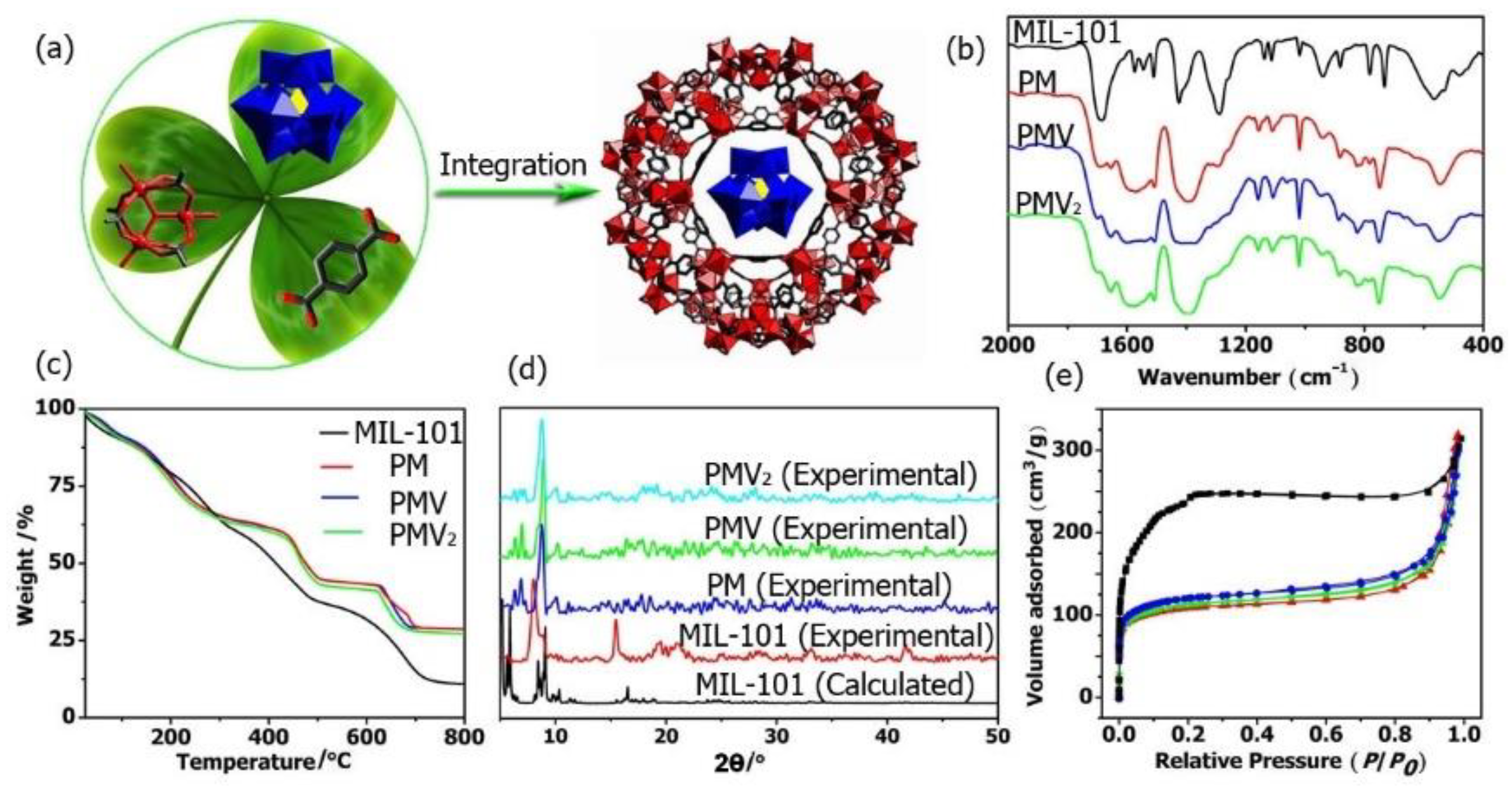

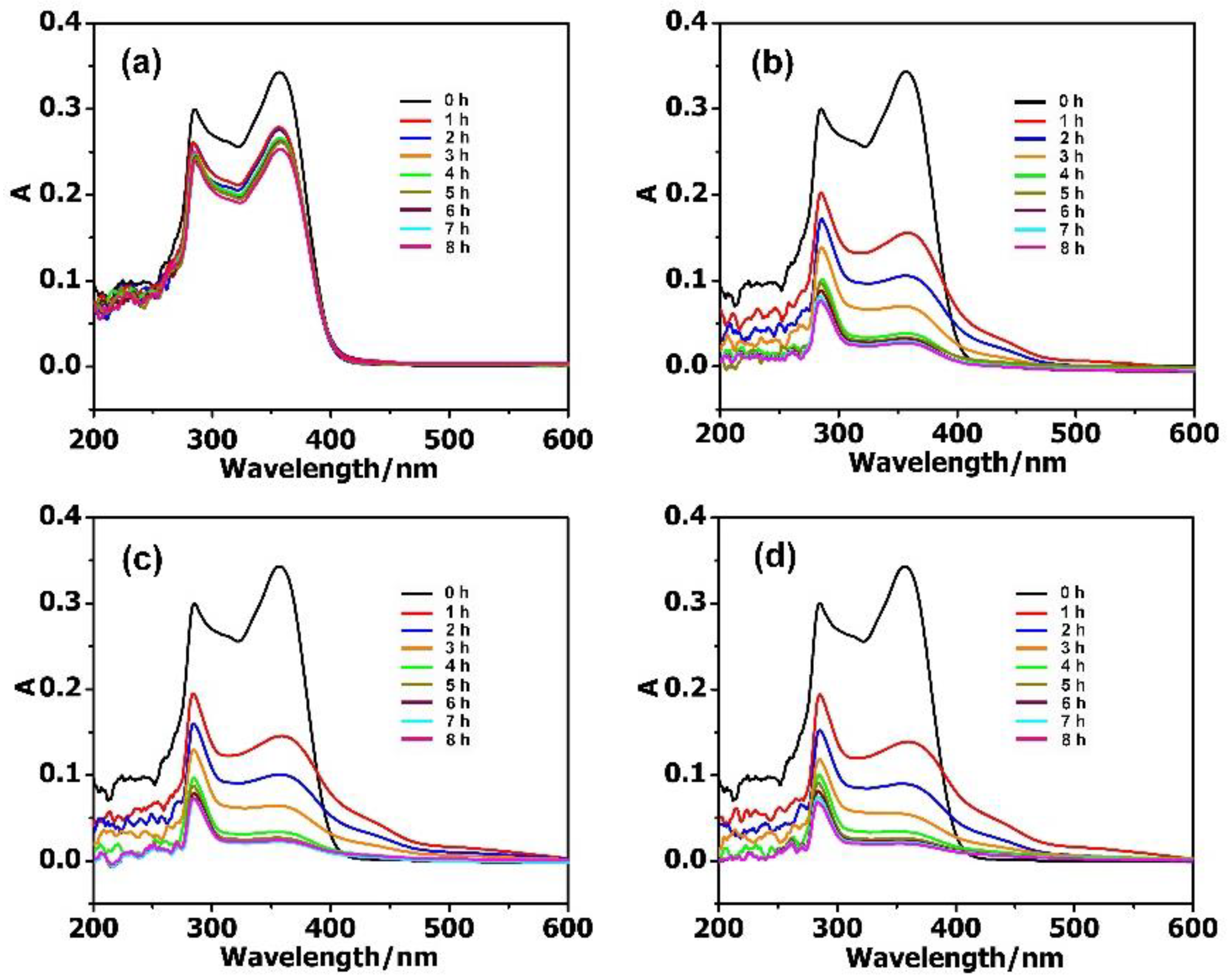
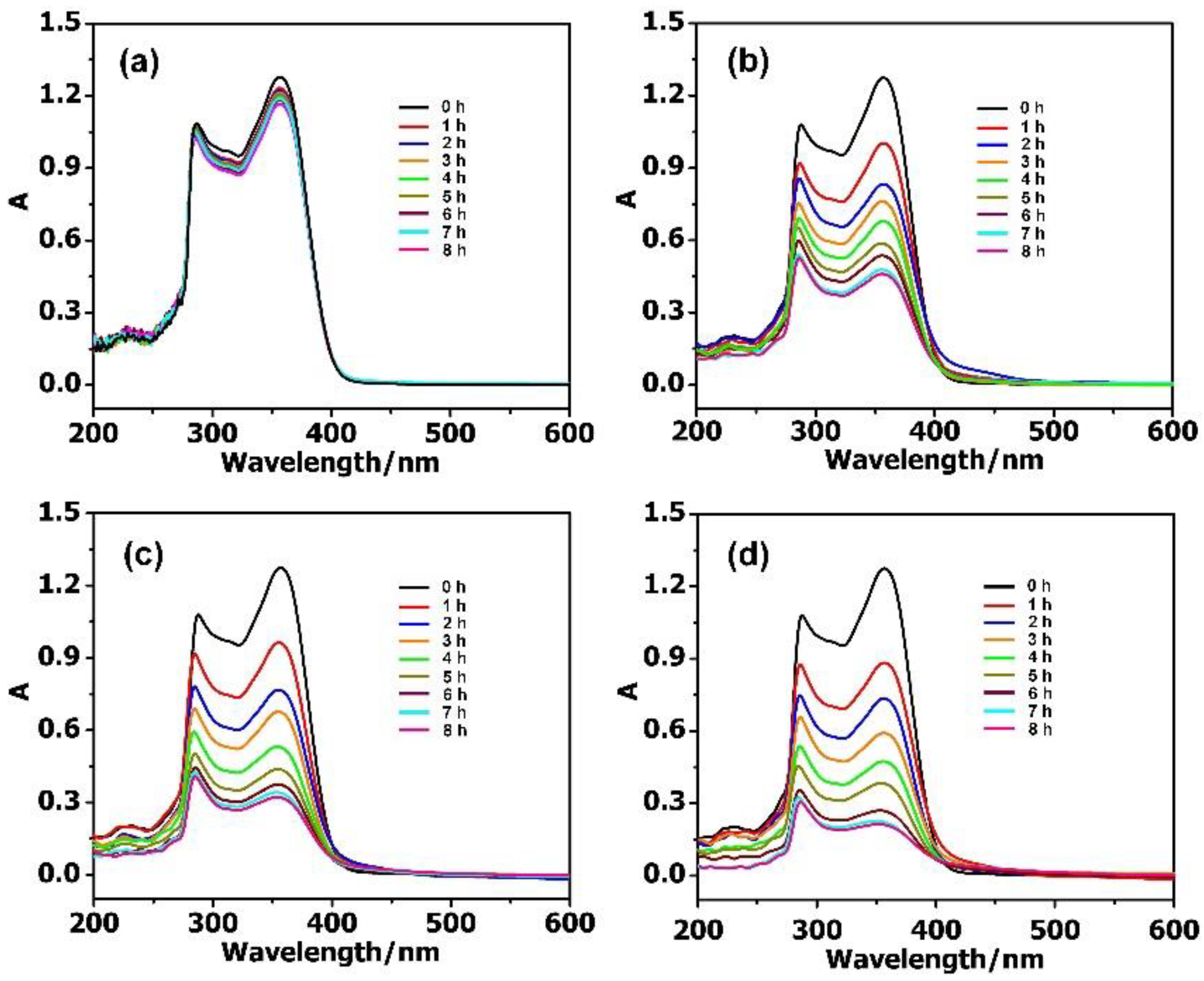
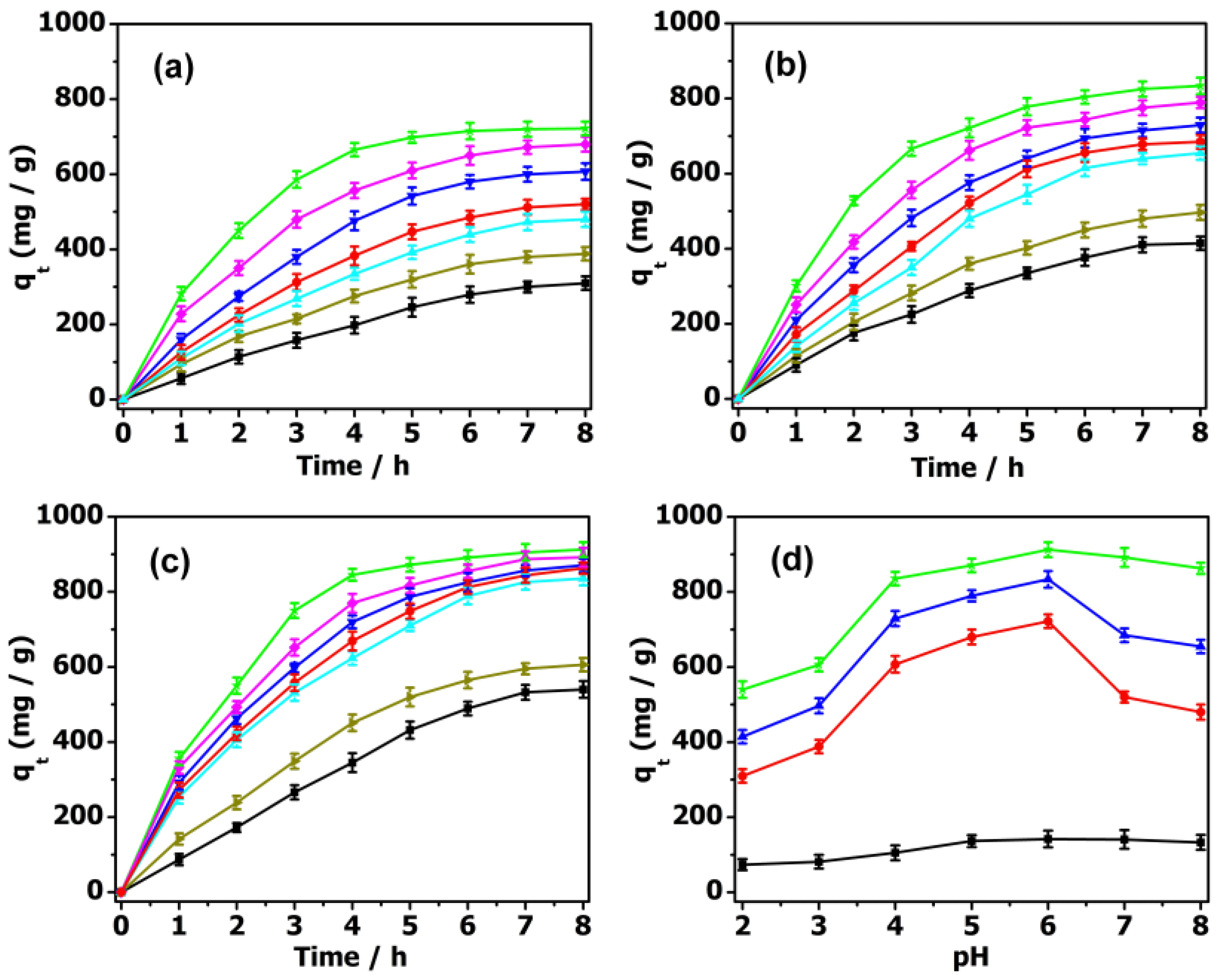

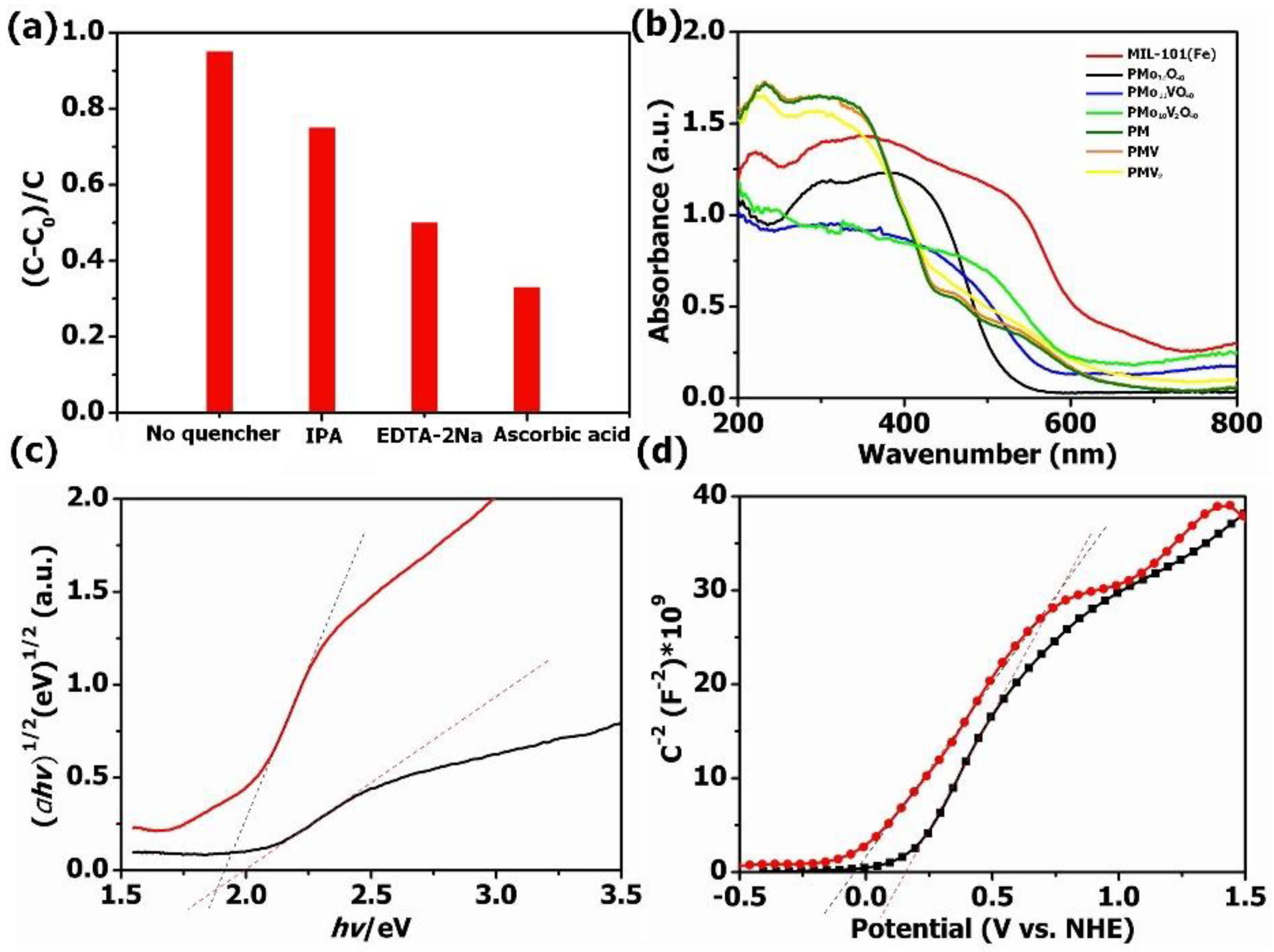

Publisher’s Note: MDPI stays neutral with regard to jurisdictional claims in published maps and institutional affiliations. |
© 2022 by the authors. Licensee MDPI, Basel, Switzerland. This article is an open access article distributed under the terms and conditions of the Creative Commons Attribution (CC BY) license (https://creativecommons.org/licenses/by/4.0/).
Share and Cite
Lan, Q.; Jin, S.; Yang, B.; Zhang, Z.; Li, X.; Xie, H.; Jin, X.; Zhang, H.; Zhao, Q. Filling Polyoxoanions into MIL-101(Fe) for Adsorption of Organic Pollutants with Facile and Complete Visible Light Photocatalytic Decomposition. Molecules 2022, 27, 3404. https://doi.org/10.3390/molecules27113404
Lan Q, Jin S, Yang B, Zhang Z, Li X, Xie H, Jin X, Zhang H, Zhao Q. Filling Polyoxoanions into MIL-101(Fe) for Adsorption of Organic Pollutants with Facile and Complete Visible Light Photocatalytic Decomposition. Molecules. 2022; 27(11):3404. https://doi.org/10.3390/molecules27113404
Chicago/Turabian StyleLan, Qing, Sujuan Jin, Bohan Yang, Zhiming Zhang, Xuyang Li, Haiquan Xie, Xiaoli Jin, Huan Zhang, and Qiang Zhao. 2022. "Filling Polyoxoanions into MIL-101(Fe) for Adsorption of Organic Pollutants with Facile and Complete Visible Light Photocatalytic Decomposition" Molecules 27, no. 11: 3404. https://doi.org/10.3390/molecules27113404
APA StyleLan, Q., Jin, S., Yang, B., Zhang, Z., Li, X., Xie, H., Jin, X., Zhang, H., & Zhao, Q. (2022). Filling Polyoxoanions into MIL-101(Fe) for Adsorption of Organic Pollutants with Facile and Complete Visible Light Photocatalytic Decomposition. Molecules, 27(11), 3404. https://doi.org/10.3390/molecules27113404




